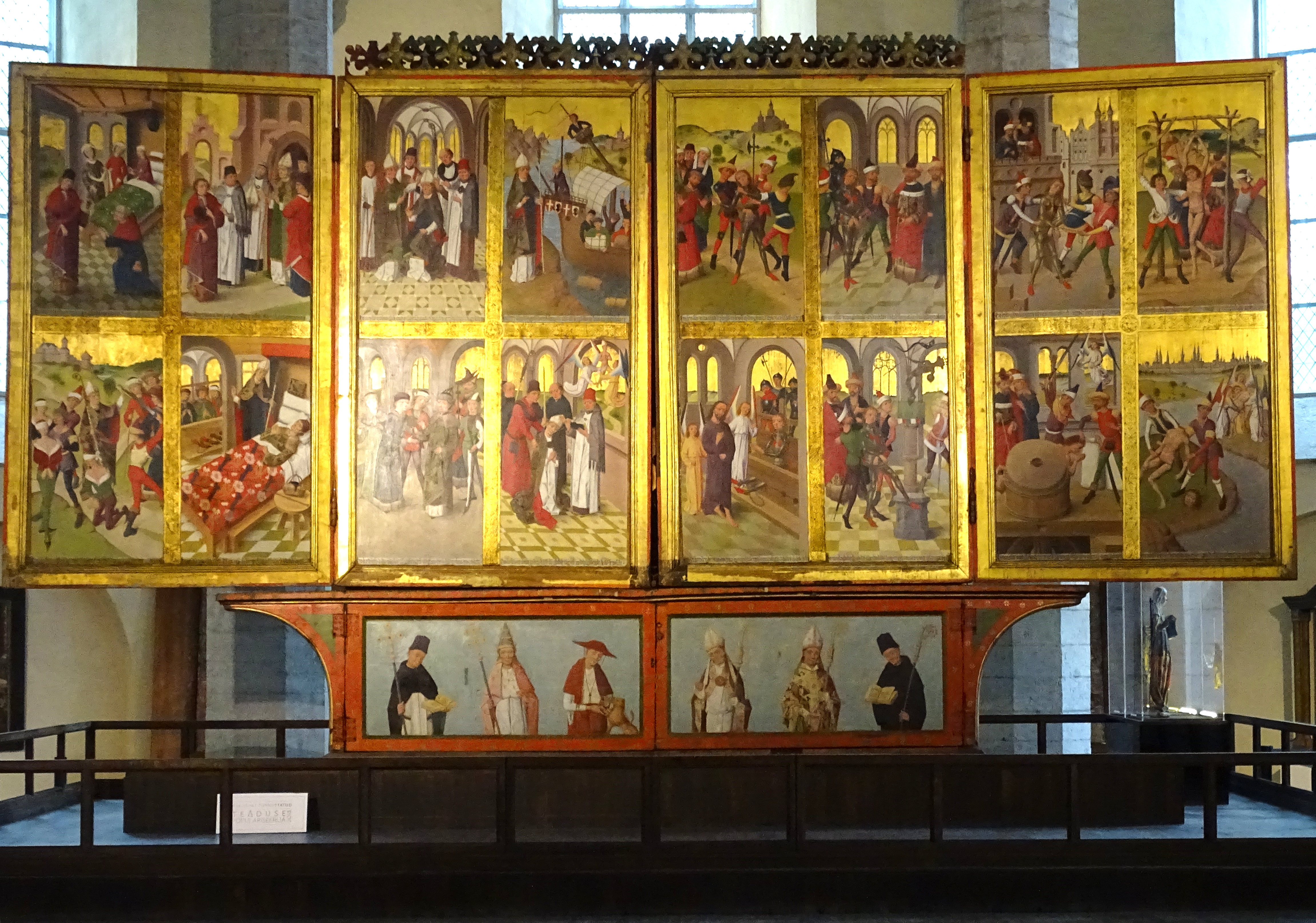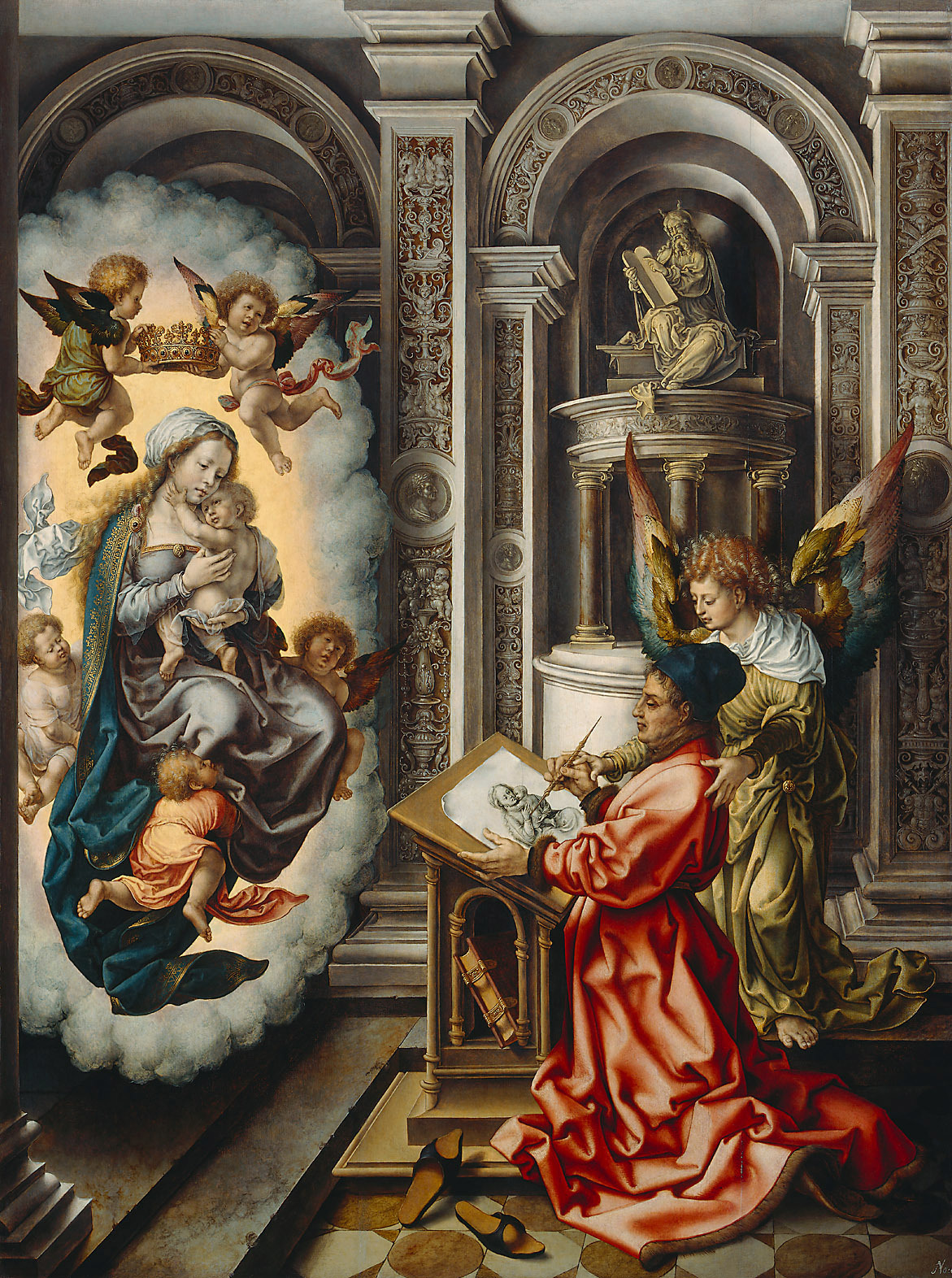|
Lamentation (Gerard David)
The ''Lamentation of Christ'' is a painting of the common subject of the Lamentation of Christ by the Early Netherlandish painting, painter and manuscript Miniature (illuminated manuscript), illuminator Gerard David, originally a wing of a now dismantled and lost altarpiece. Description It portrays the body of Jesus Christ, Christ wrapped in his shroud and being anointed. Mary Magdalene is at his feet, as the Virgin Mary holds him in her arms, weeping for his death watched over by John the Apostle, Saint John. Four other grieving figures are present; they may be Saint Anne, the mother of the Virgin, and women who followed Christ. Style While its exact dating is debated, it seems likely that it was completed between 1515 and 1523. This painting and David's ''Adoration of the Kings (Gerard David, London), Adoration of the Kings'', also in the National Gallery (NG 1079), were two wings from a single altarpiece. The theme of the ''Lamentation of Christ'' was common in medieval a ... [...More Info...] [...Related Items...] OR: [Wikipedia] [Google] [Baidu] |
Oil Painting
Oil painting is the process of painting with pigments with a medium of drying oil as the binder. It has been the most common technique for artistic painting on wood panel or canvas for several centuries, spreading from Europe to the rest of the world. The advantages of oil for painting images include "greater flexibility, richer and denser colour, the use of layers, and a wider range from light to dark". But the process is slower, especially when one layer of paint needs to be allowed to dry before another is applied. The oldest known oil paintings were created by Buddhist artists in Afghanistan and date back to the 7th century AD. The technique of binding pigments in oil was later brought to Europe in the 15th century, about 900 years later. The adoption of oil paint by Europeans began with Early Netherlandish painting in Northern Europe, and by the height of the Renaissance, oil painting techniques had almost completely replaced the use of tempera paints in the majority ... [...More Info...] [...Related Items...] OR: [Wikipedia] [Google] [Baidu] |
Polyptych
A polyptych ( ; Greek: ''poly-'' "many" and ''ptychē'' "fold") is a painting (usually panel painting) which is divided into sections, or panels. Specifically, a "diptych" is a two-part work of art; a "triptych" is a three-part work; a tetraptych or quadriptych has four parts, and so on. Historically, polyptychs typically displayed one "central" or "main" panel that was usually the largest of the attachments; the other panels are called "side" panels, or "wings". Sometimes, as evident in the Ghent and Isenheim works (see below), the hinged panels can be varied in arrangement to show different "views" or "openings" in the piece. The upper panels often depict static scenes, while the lower register, the predella, often depict small narrative scenes. Polyptychs were most commonly created by early Renaissance painters, the majority of whom designed their works to be altarpieces in churches and cathedrals. The polyptych form of art was also quite popular among ukiyo-e printmakers ... [...More Info...] [...Related Items...] OR: [Wikipedia] [Google] [Baidu] |
Paintings Of The Virgin Mary
Painting is the practice of applying paint, pigment, color or other medium to a solid surface (called the "matrix" or "support"). The medium is commonly applied to the base with a brush, but other implements, such as knives, sponges, and airbrushes, can be used. In art, the term ''painting ''describes both the act and the result of the action (the final work is called "a painting"). The support for paintings includes such surfaces as walls, paper, canvas, wood, glass, lacquer, pottery, leaf, copper and concrete, and the painting may incorporate multiple other materials, including sand, clay, paper, plaster, gold leaf, and even whole objects. Painting is an important form in the visual arts, bringing in elements such as drawing, composition, gesture (as in gestural painting), narration (as in narrative art), and abstraction (as in abstract art). Paintings can be naturalistic and representational (as in still life and landscape painting), photographic, abstract, narra ... [...More Info...] [...Related Items...] OR: [Wikipedia] [Google] [Baidu] |
Paintings By Gerard David
Painting is the practice of applying paint, pigment, color or other medium to a solid surface (called the "matrix" or "support"). The medium is commonly applied to the base with a brush, but other implements, such as knives, sponges, and airbrushes, can be used. In art, the term ''painting ''describes both the act and the result of the action (the final work is called "a painting"). The support for paintings includes such surfaces as walls, paper, canvas, wood, glass, lacquer, pottery, leaf, copper and concrete, and the painting may incorporate multiple other materials, including sand, clay, paper, plaster, gold leaf, and even whole objects. Painting is an important form in the visual arts, bringing in elements such as drawing, composition, gesture (as in gestural painting), narration (as in narrative art), and abstraction (as in abstract art). Paintings can be naturalistic and representational (as in still life and landscape painting), photographic, abstract ... [...More Info...] [...Related Items...] OR: [Wikipedia] [Google] [Baidu] |
1515 Paintings
__NOTOC__ Year 1515 ( MDXV) was a common year starting on Monday (link will display the full calendar) of the Julian calendar. Events January–June * January 25 – Francis I of France is crowned (reigns until 1547). * May 13 – Mary Tudor, Queen of France, and Charles Brandon, 1st Duke of Suffolk, are officially married at Greenwich (near London). * June 13 – Battle of Turnadag: The army of Ottoman sultan Selim I defeats the beylik of Dulkadir under Bozkurt of Dulkadir. July–December * July 2 – Manchester Grammar School is endowed by Hugh Oldham, the first free grammar school in England. * July 22 – At the First Congress of Vienna, a double wedding takes place to cement agreements. Louis, only son of King Vladislaus II of Hungary, marries Mary of Austria, granddaughter of Maximilian I, Holy Roman Emperor; and Mary's brother, Archduke Ferdinand, marries Vladislaus' daughter, Anna. * August 25 – Conquistador Diego ... [...More Info...] [...Related Items...] OR: [Wikipedia] [Google] [Baidu] |
Art Treasures Exhibition, Manchester 1857
The Art Treasures of Great Britain was an exhibition of fine art held in Manchester, England, from 5 May to 17 October 1857.''Exhibition of art treasures of the United Kingdom, held at Manchester in 1857. Report of the executive committee'' 1859. Many details in this article are taken from this comprehensive record of the exhibition. It remains the largest art exhibition to be held in the UK,Art Treasures in Manchester: 150 years on Manchester Art Gallery possibly in the w ... [...More Info...] [...Related Items...] OR: [Wikipedia] [Google] [Baidu] |
Monken Hadley
Monken Hadley is a place in the London Borough of Barnet. An ancient country village north of Barnet, it is now a suburban development on the very edge of Greater London north north-west of Charing Cross, while retaining much of its rural character. History The old English place name "Hadley" means "heathery", a woodland clearing which is covered in heather. The prefix "Monken" refers to the fact that the parish was a possession of the monks of Walden Abbey. The main site of the Battle of Barnet in 1471, one of the two principal engagements of the Wars of the Roses, was in the parish of Monken Hadley. Yorkist troops advanced through the village, although the action took place north (Hadley Wood) and west (Hadley Green) of the settlement. Although the retreat of the forces of Lord William Hastings (at the hands of the Earl of Oxford) took place in the parish of Barnet, all of the other key engagements were within Monken Hadley parish, including the historically signific ... [...More Info...] [...Related Items...] OR: [Wikipedia] [Google] [Baidu] |
Maubeuge
Maubeuge (; historical nl, Mabuse or nl, Malbode; pcd, Maubeuche) is a commune in the Nord department in northern France. It is situated on both banks of the Sambre (here canalized), east of Valenciennes and about from the Belgian border. History Maubeuge (ancient ''Malbodium'', from Latin, derived from the Old Frankish name ''Malboden'', meaning "assizes of Boden") owes its origin to Maubeuge Abbey, a double monastery, for men and women, founded in the 7th century by Saint Aldego, the relics of whom are preserved in the church. It subsequently belonged to the territory of Hainaut. The town was part of the Spanish Netherlands and changed hands a number of times before it was finally ceded to France in the 1678 Treaty of Nijmegen. As part of Vauban's ''pré carré'' plan that protected France's northern borders with a double line of fortresses, it was extensively fortified as directed by Louis XIV of France. Besieged in 1793 by Prince Josias of Saxe-Coburg-Saa ... [...More Info...] [...Related Items...] OR: [Wikipedia] [Google] [Baidu] |
Jan Gossaert
Jan Gossaert (c. 1478 – 1 October 1532) was a French-speaking painter from the Low Countries also known as Jan Mabuse (the name he adopted from his birthplace, Maubeuge) or Jennyn van Hennegouwe (County of Hainaut, Hainaut), as he called himself when he matriculated in the Guild of Saint Luke, at Antwerp, in 1503. He was one of the first painters of Dutch and Flemish Renaissance painting to visit Italy and Rome, which he did in 1508–09, and a leader of the style known as Romanism (painting), Romanism, which brought elements of Italian Renaissance painting to the north, sometimes with a rather awkward effect. He achieved fame across at least northern Europe, and painted religious subjects, including large altarpieces, but also portraits and mythological subjects, including some nudity. From at least 1508 he was apparently continuously employed, or at least retained, by quasi-royal patrons, mostly members of the extended Habsburg family, heirs to the House of Valois, Valois ... [...More Info...] [...Related Items...] OR: [Wikipedia] [Google] [Baidu] |
Christie's
Christie's is a British auction house founded in 1766 by James Christie. Its main premises are on King Street, St James's in London, at Rockefeller Center in New York City and at Alexandra House in Hong Kong. It is owned by Groupe Artémis, the holding company of François-Henri Pinault. Sales in 2015 totalled £4.8 billion (US$7.4 billion). In 2017, the ''Salvator Mundi'' was sold for $400 million at Christie's in New York, at the time the highest price ever paid for a single painting at an auction. History Founding The official company literature states that founder James Christie (1730–1803) conducted the first sale in London, England, on 5 December 1766, and the earliest auction catalogue the company retains is from December 1766. However, other sources note that James Christie rented auction rooms from 1762, and newspaper advertisements for Christie's sales dating from 1759 have also been traced. After his death, Christie's son, James Christie the Younger (1773� ... [...More Info...] [...Related Items...] OR: [Wikipedia] [Google] [Baidu] |
Life Of The Virgin
The Life of the Virgin, showing narrative scenes from the life of Mary, the mother of Jesus, is a common subject for pictorial cycles in Christian art, often complementing, or forming part of, a cycle on the Life of Christ. In both cases the number of scenes shown varies greatly with the space available. Works may be in any medium: frescoed church walls and series of old master prints have many of the fullest cycles, but panel painting, stained glass, illuminated manuscripts, tapestries, stone sculptures and ivory carvings have many examples. Scenes shown The Life of the Virgin sometimes merges into a cycle of the Life of Christ, sometimes includes scenes from the Passion of Christ, but often jumps from the childhood of Christ to the Death of the Virgin. The Finding in the Temple, the last episode in the childhood of Christ, often ends the cycle. Important examples whose scenes are listed in the table below, include those in the Tornabuoni Chapel by Domenico Ghirlandai ... [...More Info...] [...Related Items...] OR: [Wikipedia] [Google] [Baidu] |





.jpg)


_001.jpg)
